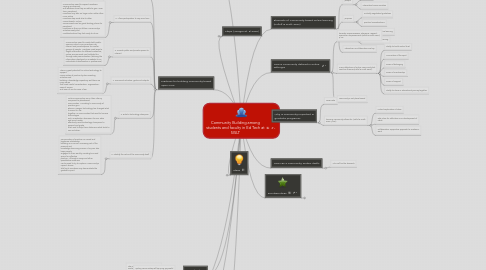
1. Step 1. Understand your community
1.1. Where is your community in its lifecycle?
1.2. Diversity: How diverse is your community?
1.3. Openness: How connected to the outside world is your community?
1.4. Technology savvy: What are your community’s technology interests and skills?
1.5. Technology tolerance: What is your community’s patience with technology?
1.6. Technology factors: What constraints are imposed by technology factors?
1.7. What is the orientation of the community?
1.8. Take an inventory of technology
2. Action Points
2.1. Meet with ET@MO about Bb space
2.2. Find other programs that are mostly online
2.3. New node
2.4. call syracuse univ to ask who coordinates their activities
3. Ideas
3.1. connect students to students
3.1.1. Sub Idea 1
3.1.2. Sub Idea 2
3.1.3. New node
3.2. connect students to professors
3.3. sense of belonging
3.4. sense of commitment
3.5. sense of ownership
3.6. sense of importance
3.7. Pallof & Pratt (2007) discuss CPsquare, in which an online community uses place based community as a metaphor: interest groups are organized into neighborhoods, households and kitchen tables. discussions take place around front porch.
3.8. Xplana
4. Context
4.1. The program consists of more online courses than face to face courses
4.2. Students in the program are both on campus and distance.
4.3. Graduate students enter the program with a wide variety of backgrounds and experiences.
4.4. Graduate students have commitments that prevent them from being able to socialize/network as much as may be desired
4.5. High attrition rates come at the cost of wasted personnel and financial resources
4.5.1. New node
4.6. Need a way for relationships and communications to continue beyond the duration of singular courses
5. How do SISLT students perceive the community in their program?
6. Considerations
6.1. Online communities will be more successful when they are supplemented with f2f interactions (Spheru, 2011, p.25)
7. Practices for building community based upon COP
7.1. 1. Provide opportunities for regular interaction
7.1.1. To establish an identity, communities need public events that happen often enough to build momentum. Researchers have found that online communities are more successful when members have had some face-to-face contact, which helps build trust more quickly and easily.
7.2. 2. Allow participation to vary over time
7.2.1. Communities need to respect members’ varying involvement and whatever time they are able to give. Over time, peripheral members may take on larger roles, while other, more active members step aside due to other commitments. Online environments can be good starting places for peripheral members as they can follow a community’s activities easily and contribute when they feel ready to do so.
7.3. 3. Provide public and private spaces to interact
7.3.1. Communities need to create both public spaces in which many members can interact and private spaces for smaller groups of people. Members need ways to target information to different audiences; online environments can facilitate this through web personalization (tailoring the information displayed on a website to an individual’s characteristics or preferences).
7.4. 4. Document activities, goals and outputs
7.4.1. There is great potential for online technology to support communities of practice by documenting activities and building a knowledge repository. But there are many issues that need careful consideration: organization, ease of access, and ease of use to name a few.
7.5. 5. Enlist a technology champion
7.5.1. Online communities are in their infancy compared to placebased communities. According to community of practice guru Etienne Wenger, technology has changed what it means to “be together.”5 Communities that want to harness technologies such as websites, discussion forums, wikis and social media effectively need technology champions to support and guide them and to help them determine what tools to use and when.
7.6. 6. Identify the value of the community itself
7.6.1. Communities of practice can reveal and legitimize relationship building as a normal, necessary part of the research and knowledge discovery process. They can also keep people engaged in their work by creating time and space for reflective practice. Although surveys and other quantitative measures can be used to try to capture a community’s impact, stories told by its members may demonstrate the greatest impact.
8. Steps (Wenger et. al 2009)
8.1. New node
9. Elements of Community based online learning (Palloff & Pratt, 2007)
9.1. people
9.1.1. presence
9.1.2. interaction/communication
9.2. purpose
9.2.1. mutually negotiated guidelines
9.2.2. practical considerations
9.3. process
9.3.1. reflection/transformative learning
9.3.2. social/constructivist learning
9.4. interaction & collaboration are key
10. Prioritize Ideas
10.1. High Priority
10.2. Medium Priority
10.3. Low Priority
11. How is community defined in online settings?
11.1. honesty, responsiveness, relevance, respect, openness, empowerment (Pallof & Pratt, 2007), p. 22
11.2. many definitions of online community but common themes (Pallof & Pratt, 2007):
11.2.1. ability to build mutual trust
11.2.2. connection of the spirit
11.2.3. sense of belonging
11.2.4. sense of membership
11.2.5. sense of support
11.2.6. ability to share in educational journey together
11.3. community is not place-based
12. Why is community important in graduate programs?
12.1. New node
12.2. learning community allows for: (Pallof & Pratt, 2007, p.26):
12.2.1. mutual exploration of ideas
12.2.2. safe place for reflection on & development of ideas
12.2.3. collaborative, supportive approach to academic work
